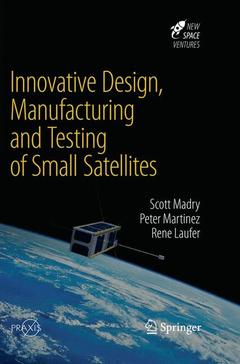Innovative Design, Manufacturing and Testing of Small Satellites, Softcover reprint of the original 1st ed. 2018 Astronautical Engineering Series
Auteurs : Madry Scott, Martinez Peter, Laufer Rene

This book details key trends involving the recent formation of scores of companies that build and launch small satellites or provide key components for small satellite constellations. The applications and usage are quite diverse and include student experiments, serious scientific experimentation, and totally new types of commercial constellations, particularly in telecommunications and remote sensing.
The explosive growth in the design, manufacturing, and launch of small satellites is one of the most dynamic aspects in the area of space exploration and exploitation today. New commercial space companies such as Planet Labs, Sky Box, OneWeb, and LeoSat are now building and launching thousands of small satellites and cubesats into orbit. Small companies and big aerospace companies alike are getting into this exciting and interesting new business.
This is a practical guide that provides advice to students, researchers, LEO satellite companies, and regulators wrestling with some of the new challenges that small satellites present as more and more companies and countries around the world enter the new small satellite arena.
Preface.- Acknowledgements.- Chapter 1: Introduction to the World of Small Satellites.- Chapter 2: Engineering, Design, and Launch Arrangements of Smallsats.- Chapter 3: Smallsats for Remote Sensing -- The Swarm is Here!.- Chapter 4: Innovative New Uses of Smallsats for Networking and Telecom.- Chapter 5: Small Satellites and the U.N. Sustainable Development Goals.- Chapter 6: Future Prospects and Policy Concerns.- Chapter 7: Potential Innovations in Space Regulatory Systems and Standards.- Chapter 8: Conclusions and Top Ten Things to Know About Small Satellites.- Appendix 1: Glossary of Terms and Acronyms.- Appendix 2: The Space Debris Mitigation Guidelines of the U.N. Committee on the Peaceful Uses of Outer Space.- Appendix 3: Resolution Adopted by the General Assembly Convention on Registration of Objects Launched into Outer Space.- Appendix 4:Convention on International Liability for Damage Caused by Space Objects.- Appendix 5: IADC Space Debris Mitigation Guidelines.- Index.
Dr. Rene Laufer is working at the Institute of Space Systems of the University of Stuttgart, Germany, in collaboration with the Space Lab in the Department of Electrical Engineering at the University of Cape Town in South Africa. He is project manager of the Stuttgart small moon satellite “Lunar Mission BW1”. Rene’s areas of expertise include astronomical, lunar and planetary exploration and systems engineering. The special focus of his systems engineering skill is in optimizing the design for small scientific satellite missions and arranging for their launch. His current research interests are thus focused on small satellite technology and development, future lunar and planetary exploration and utilization as well as Earth observation. Until 2003 Rene worked for nearly ten years at German Aerospace Center (DLR) in planetary exploration supporting missions in different roles. Rene graduated in Aerospace Engineering at Technical University of Berlin, Germany, and received his PhD from the University of Stuttgart. Also he was a freelancer in event management and actively involved with the Berlin Planetarium and Observatory for more than ten years in lecturing. Being also an alumnus of the International Space University (ISU) he returns to the ISU regularly since 2004 for teaching. He is involved in small satellite related conferences and symposia and is one of the chairs of the IAA Permanent Small Satellite Committee.
Professor Peter Martinez has been appointed to coordinate the Space Studies Program at UCT. Prior to joining UCT he was centrally involved in a number of developments leading to the reinvigoration of the South African space program. Professor Martinez was previously with the South African Astronomical Observtory, a facility operated by the National Research Foundation. He is the current chairman of the South African Council for Space Affairss and has extensive experience in multilateral space diplomacy through his invol
Date de parution : 12-2018
Ouvrage de 161 p.
15.5x23.5 cm
Date de parution : 05-2018
Ouvrage de 161 p.
15.5x23.5 cm



